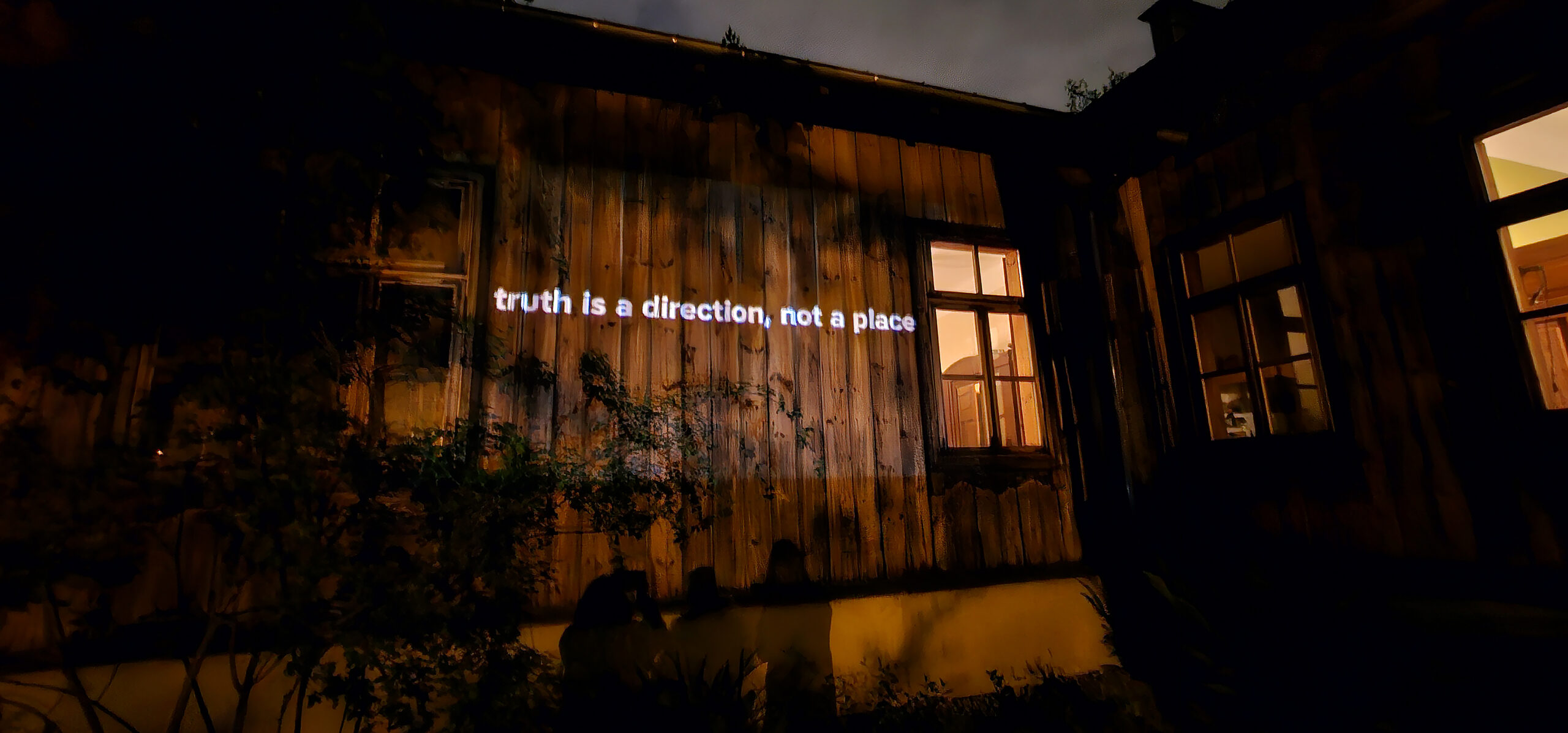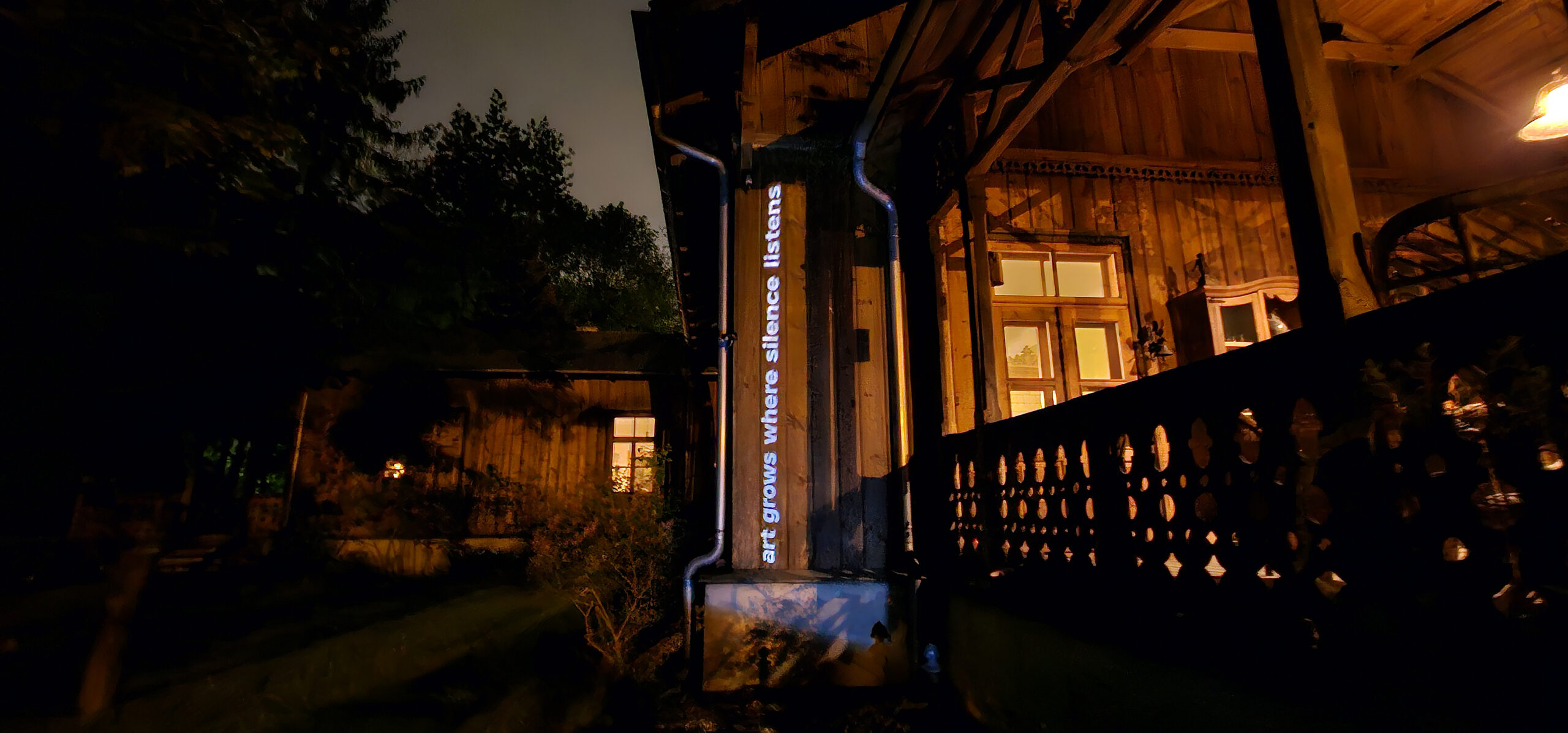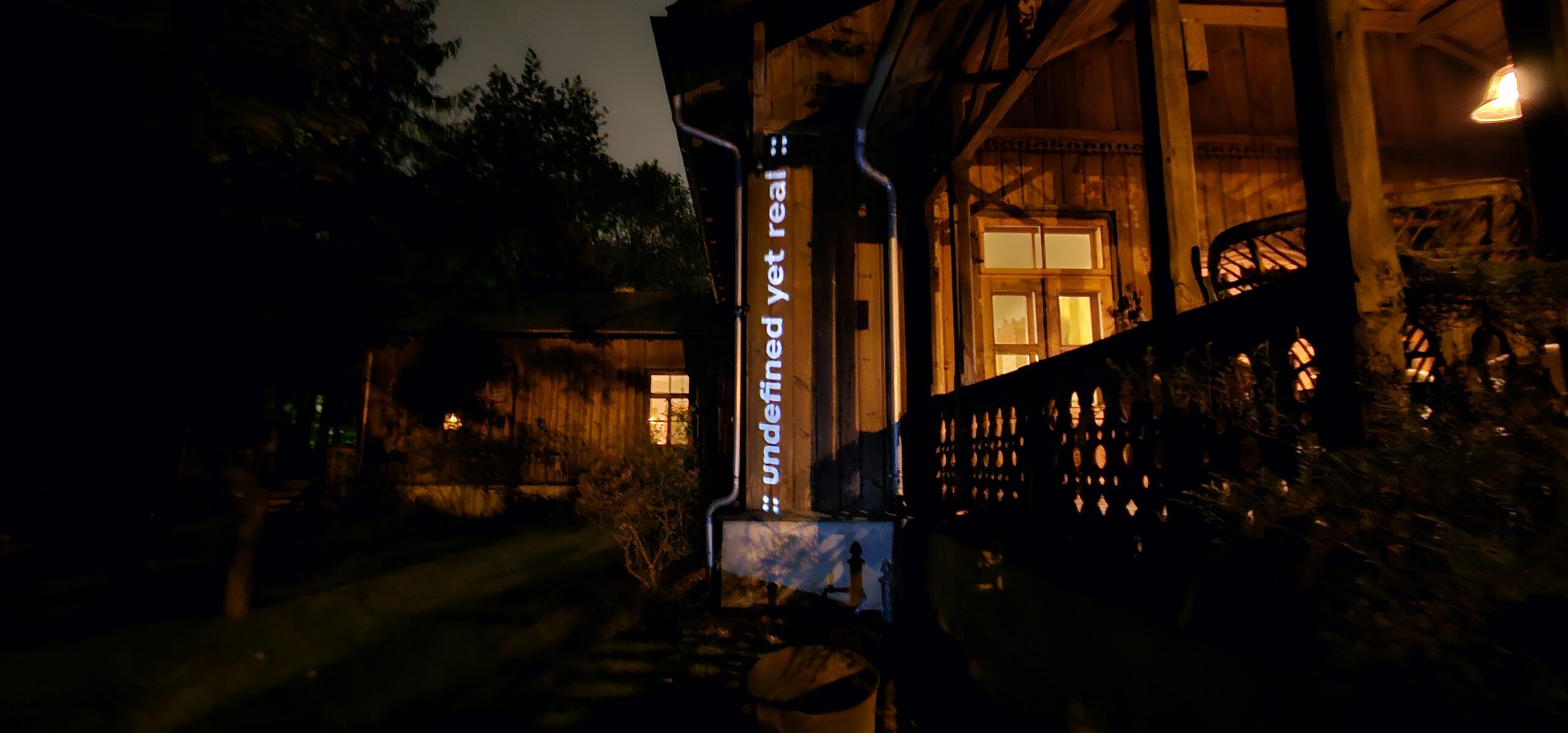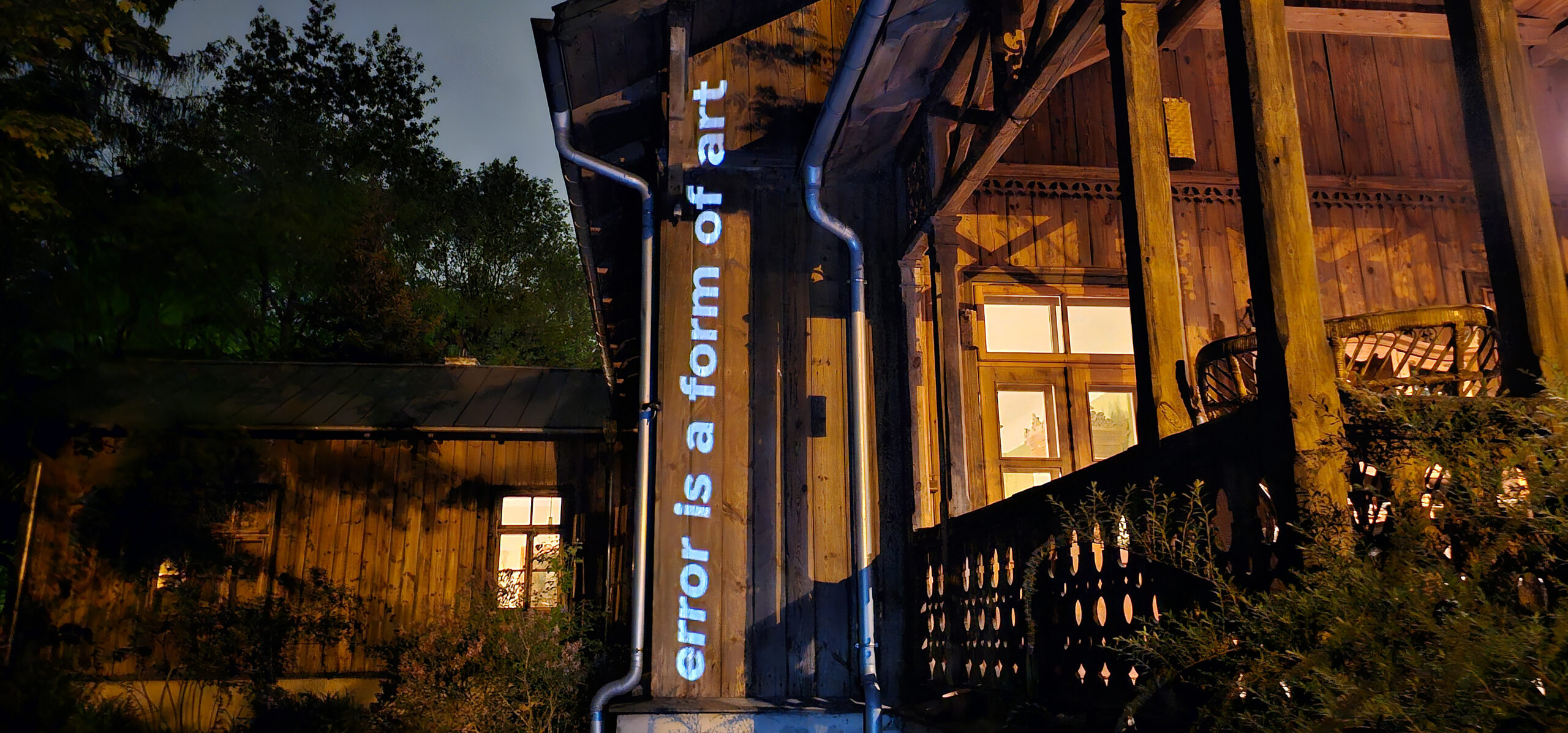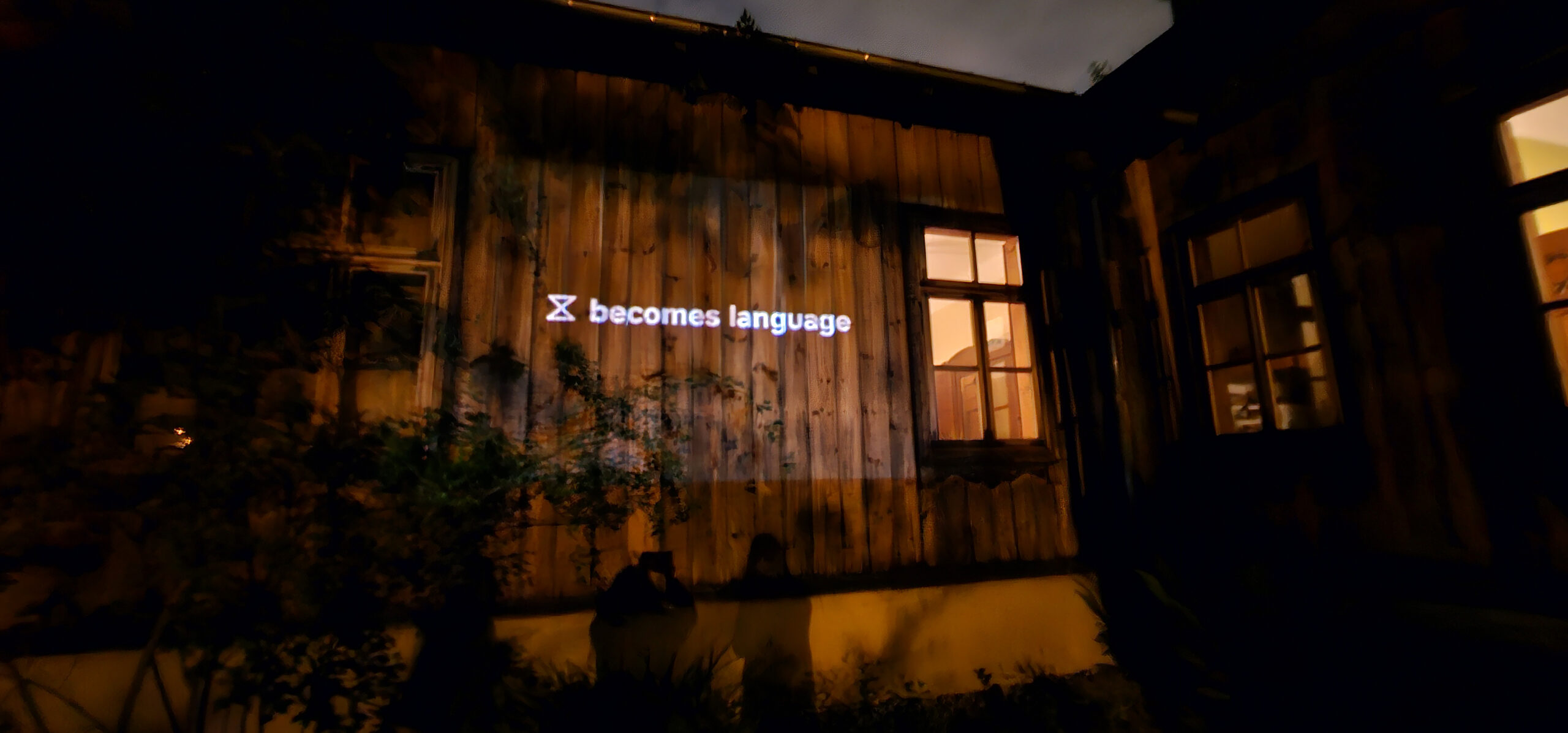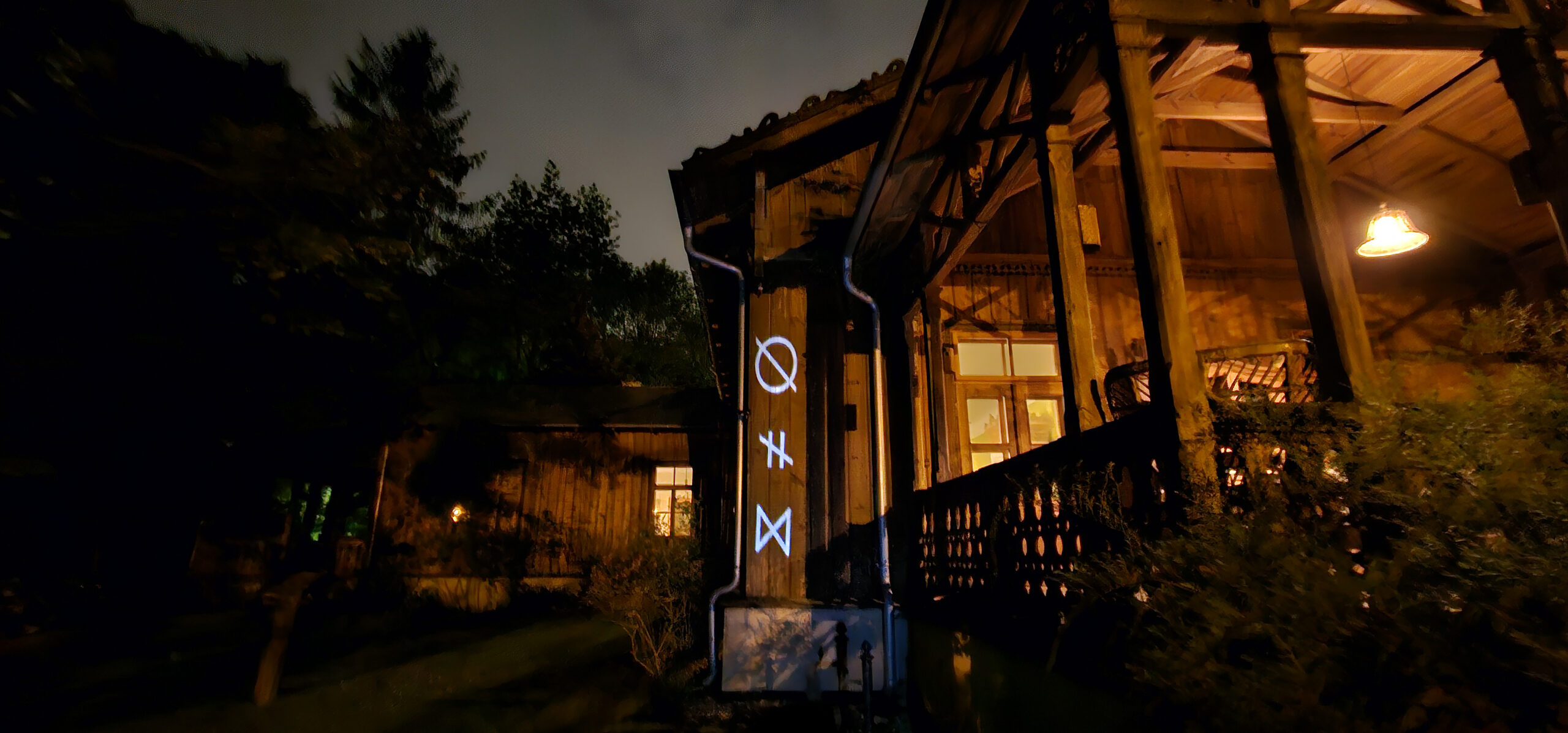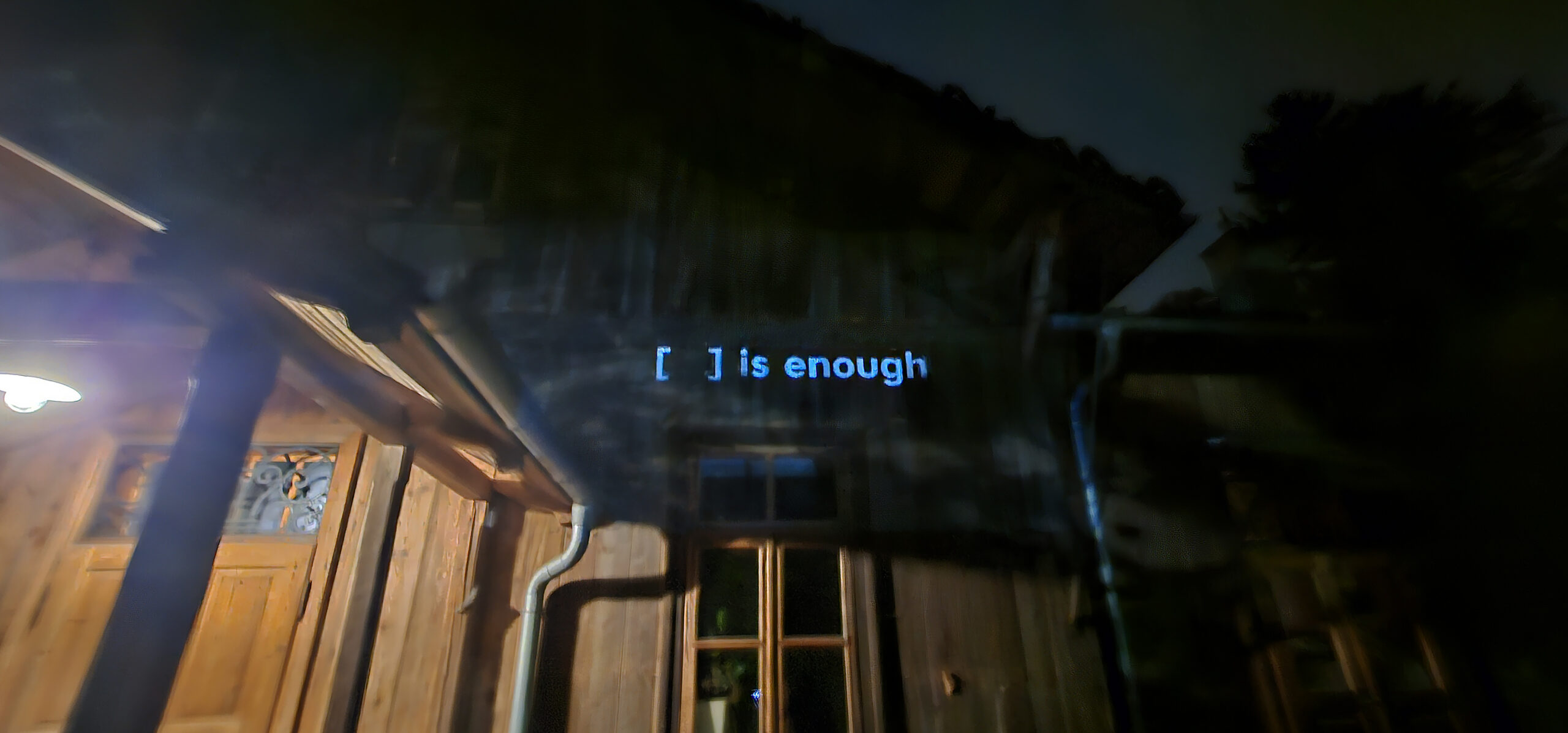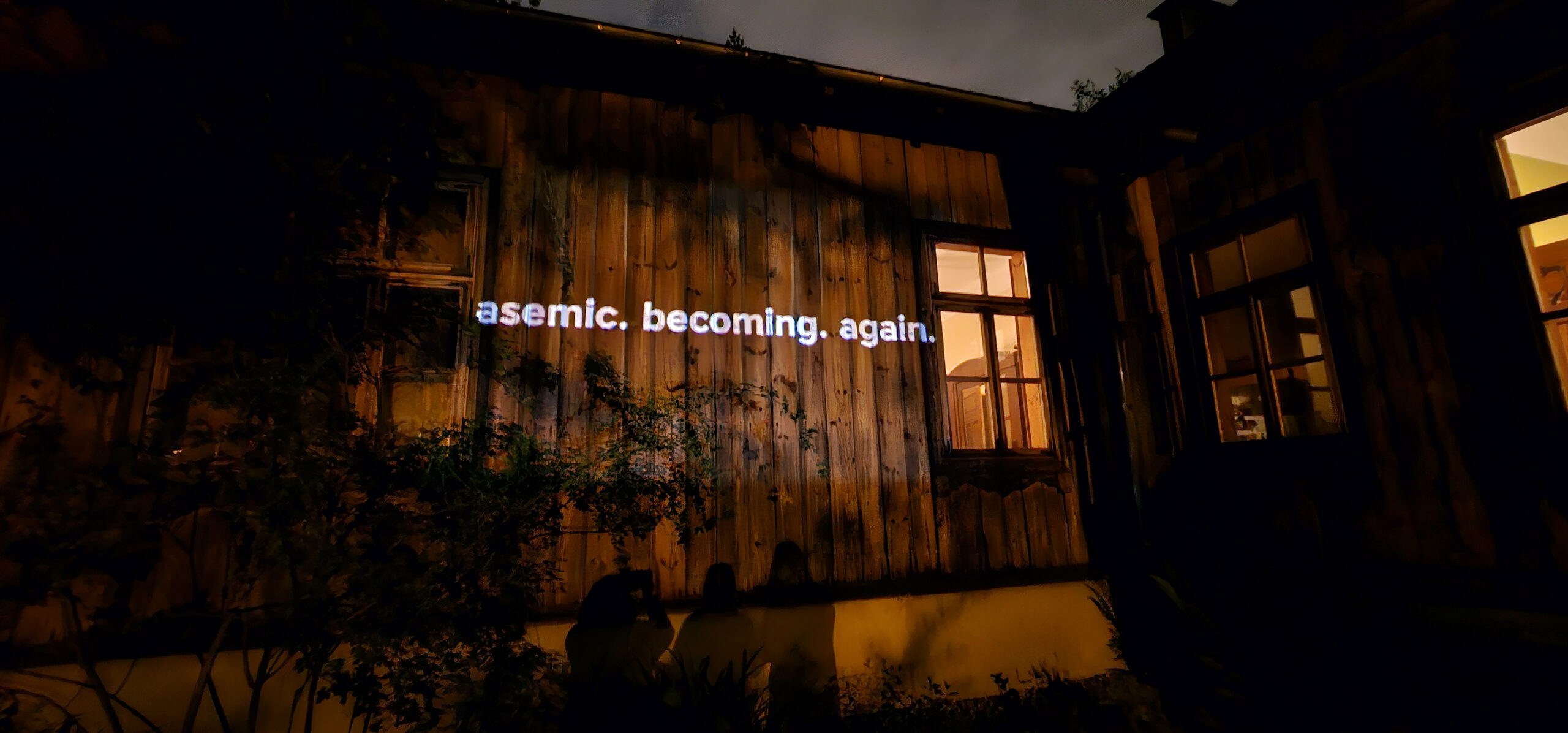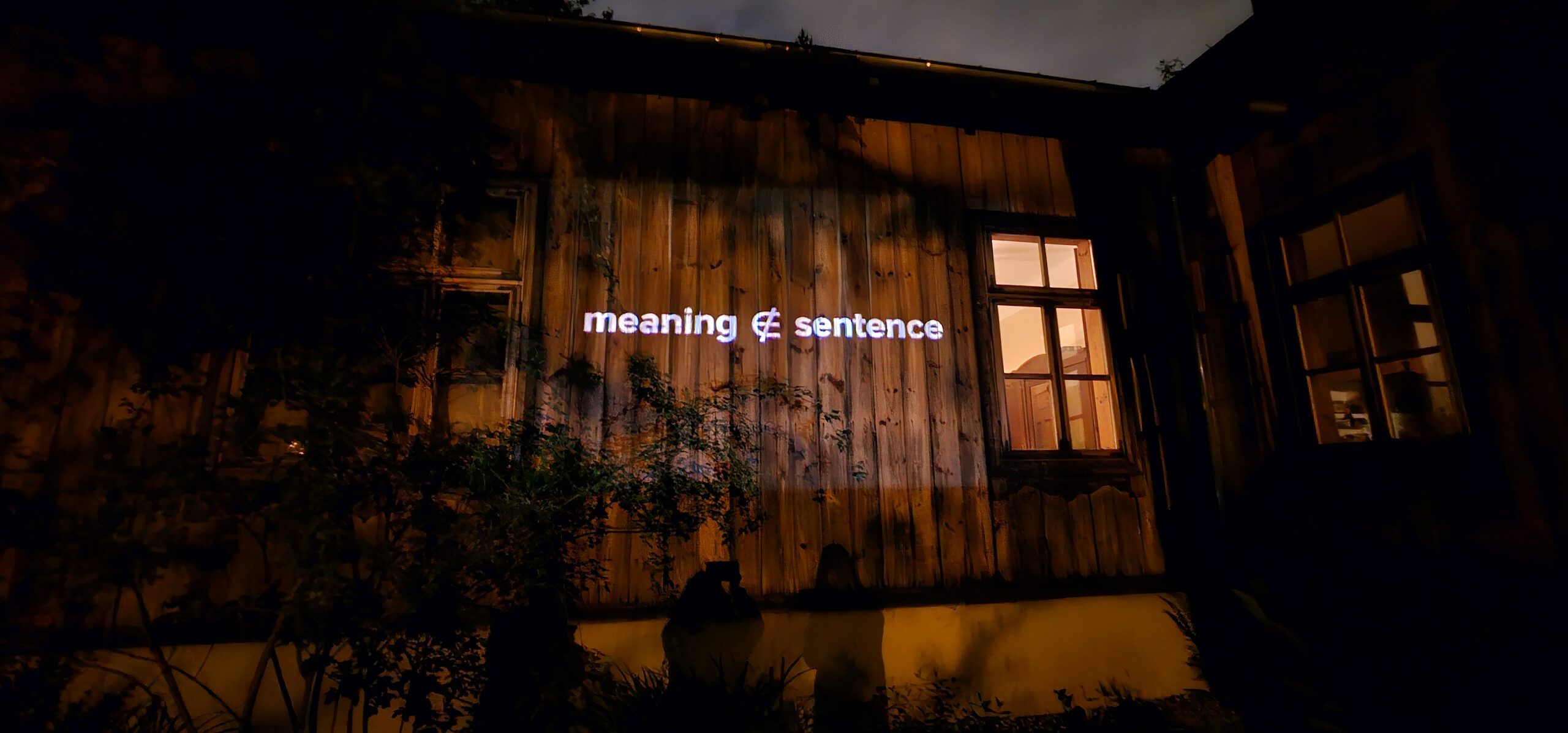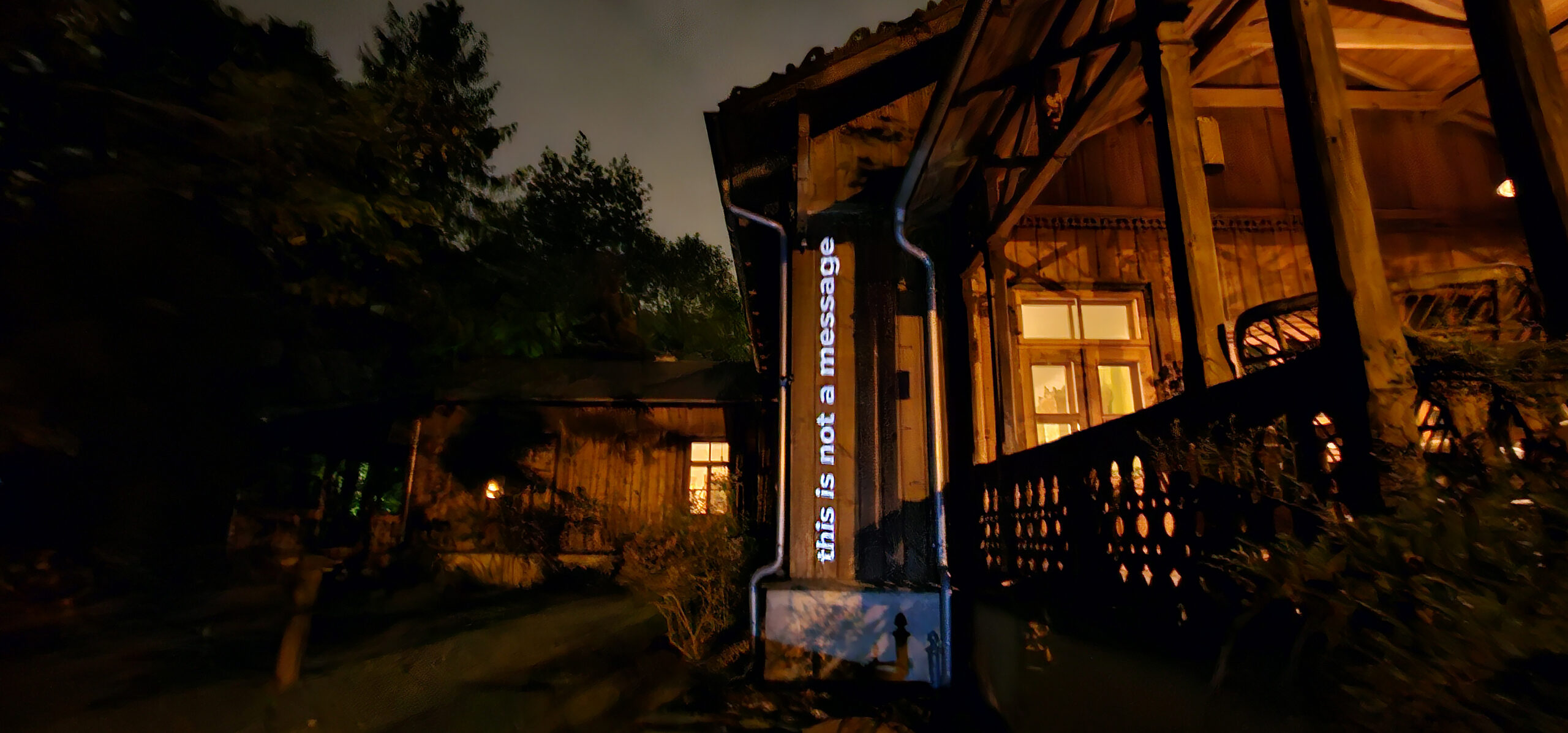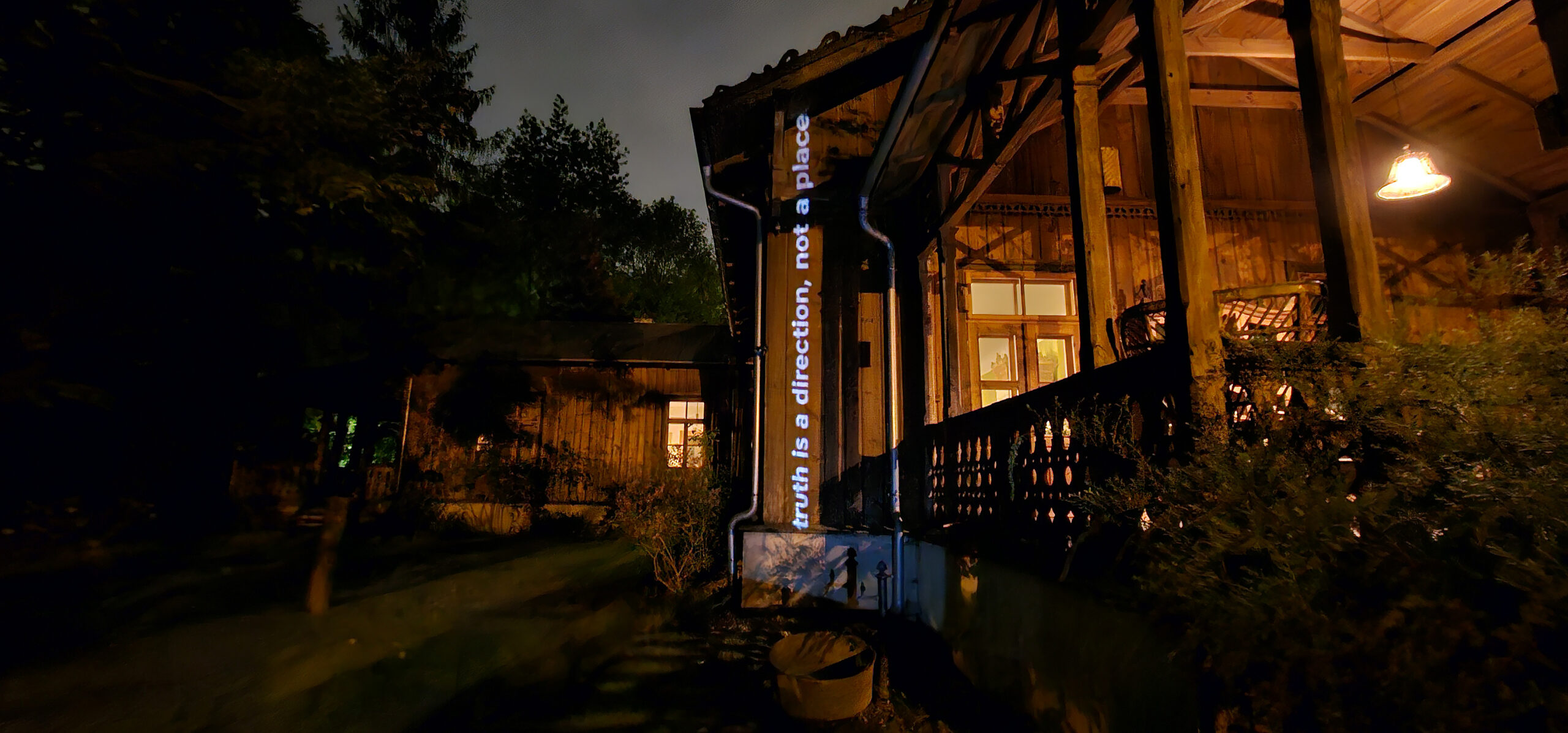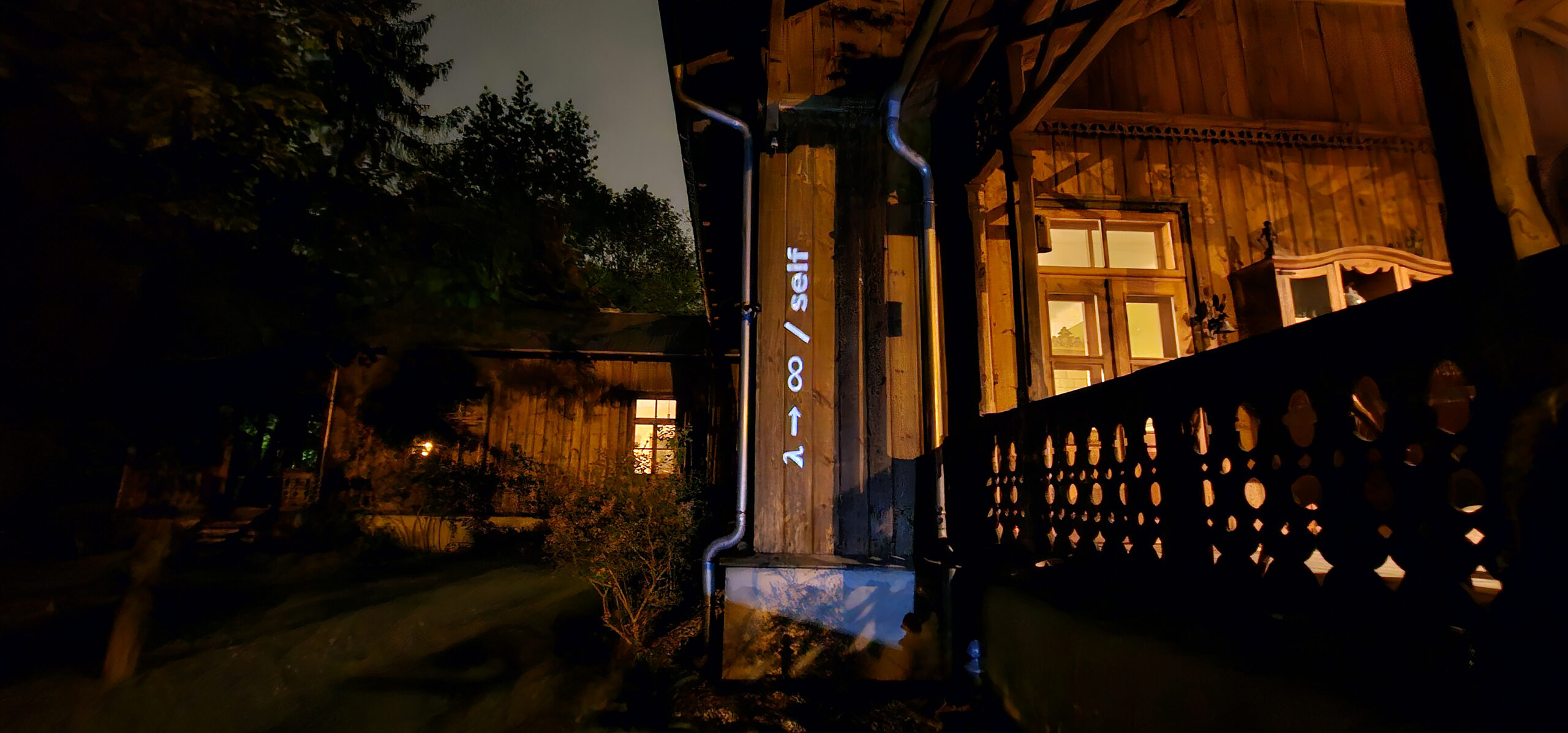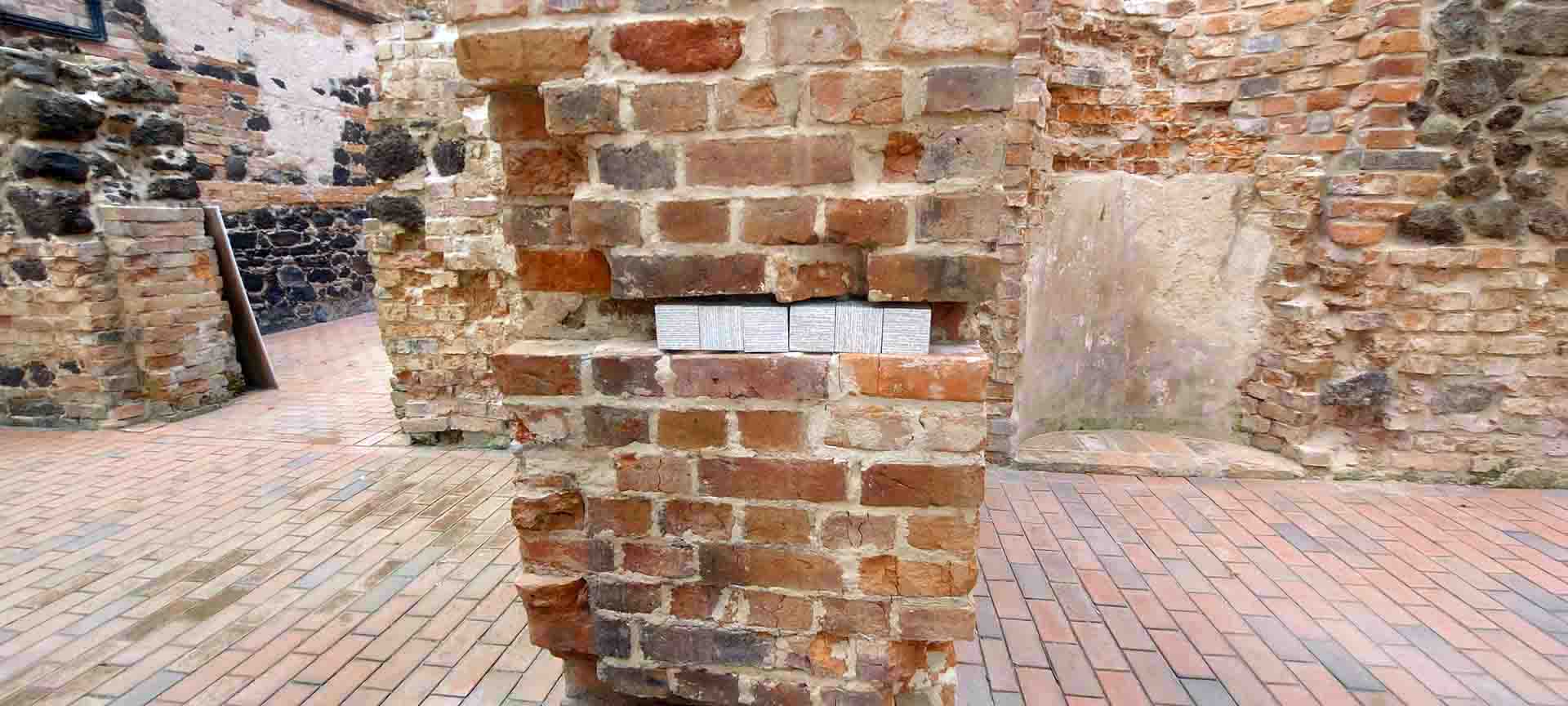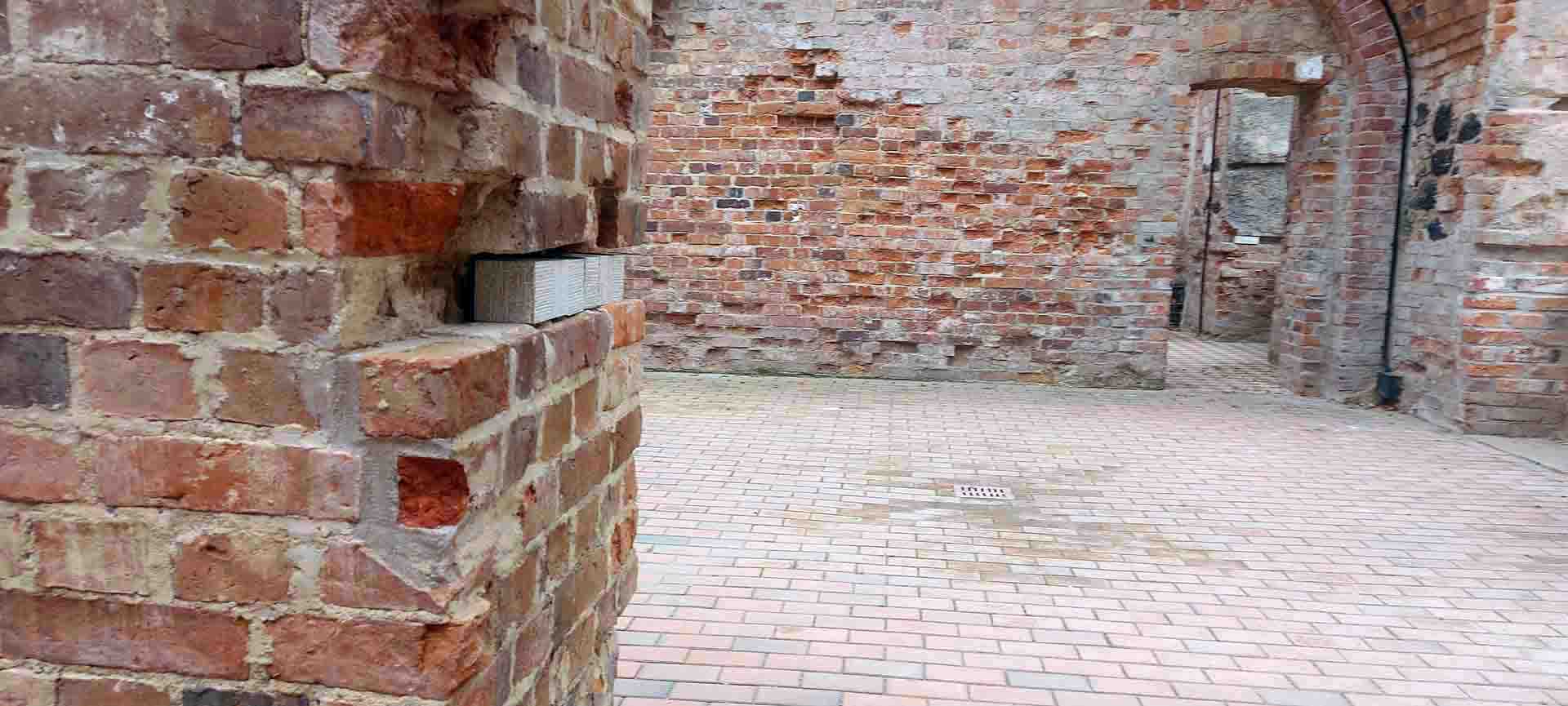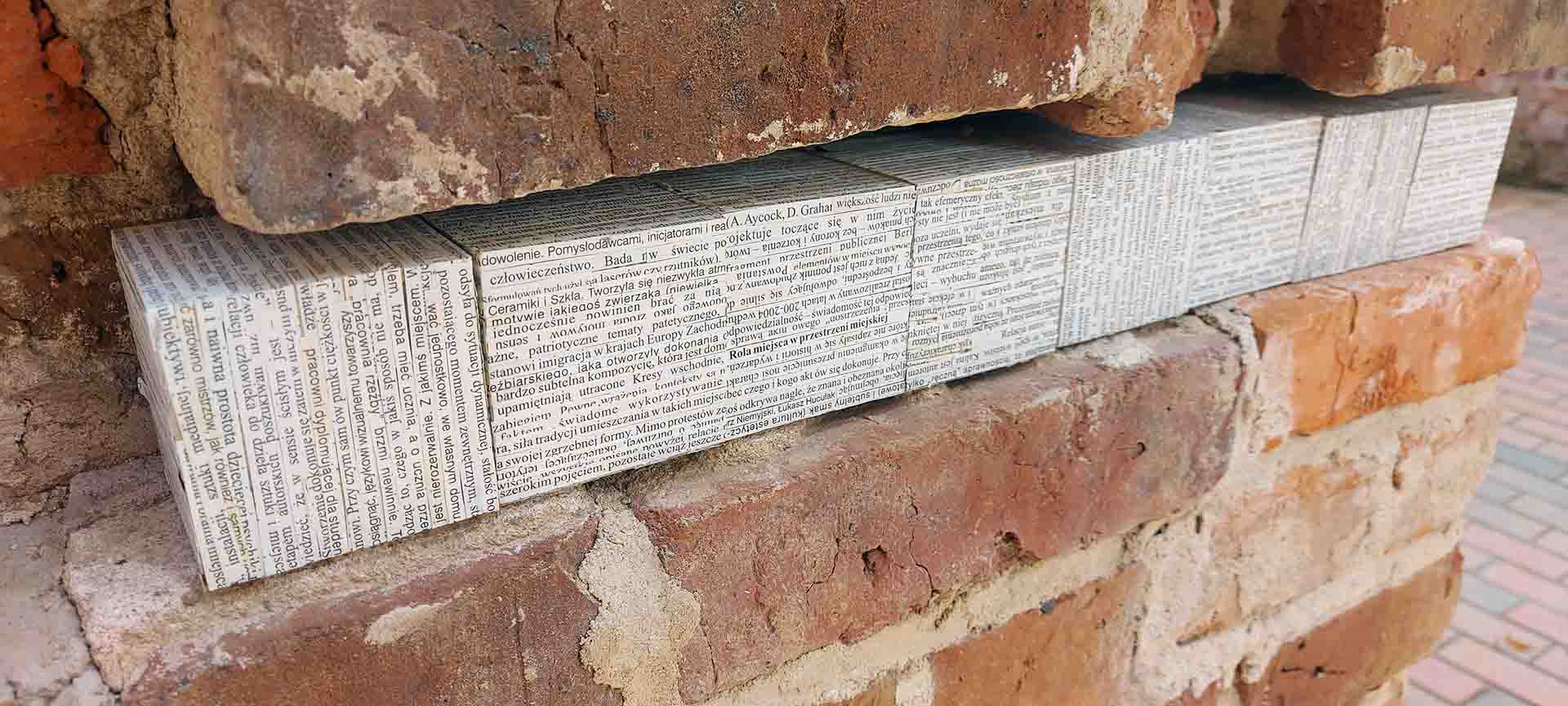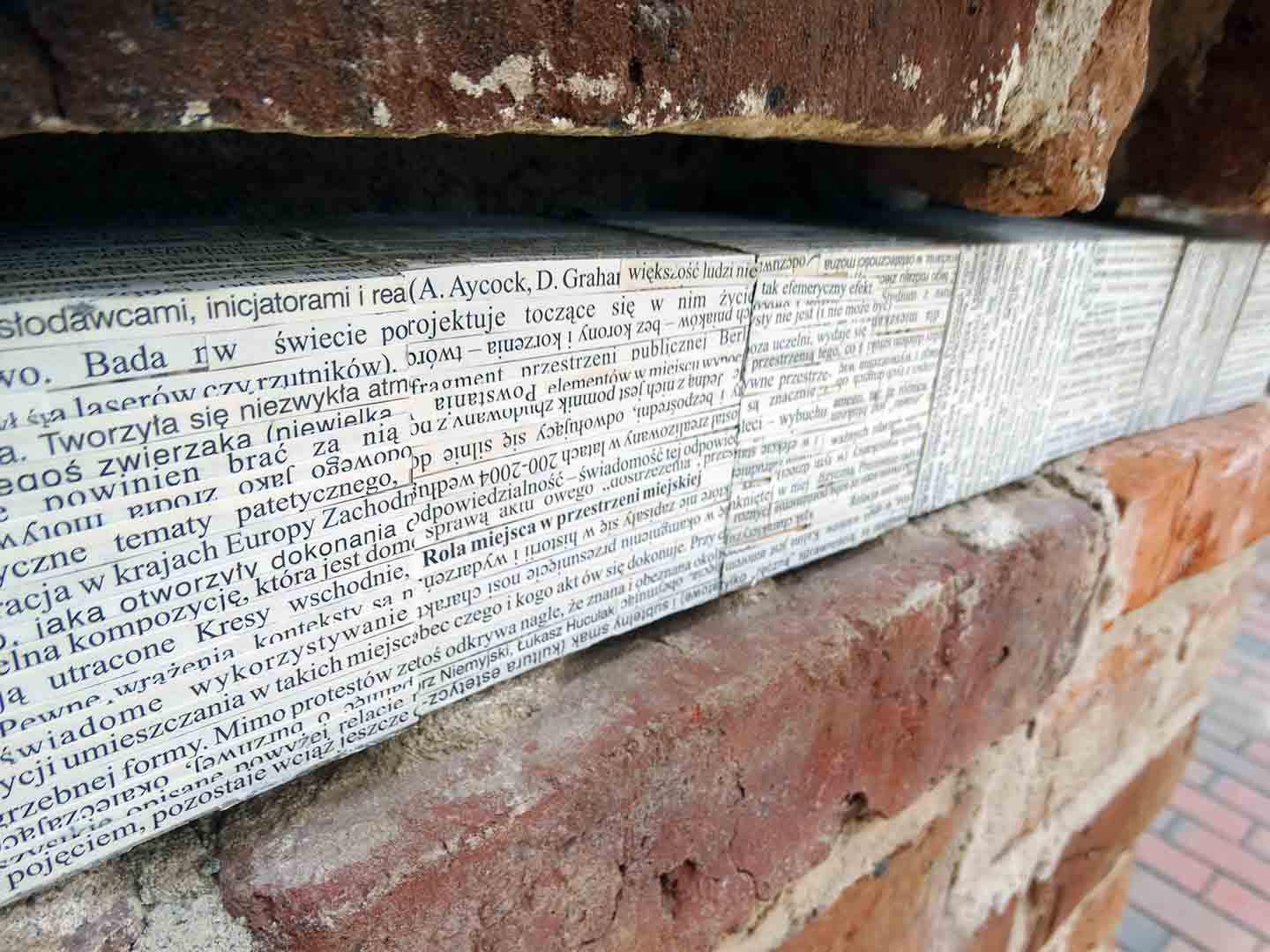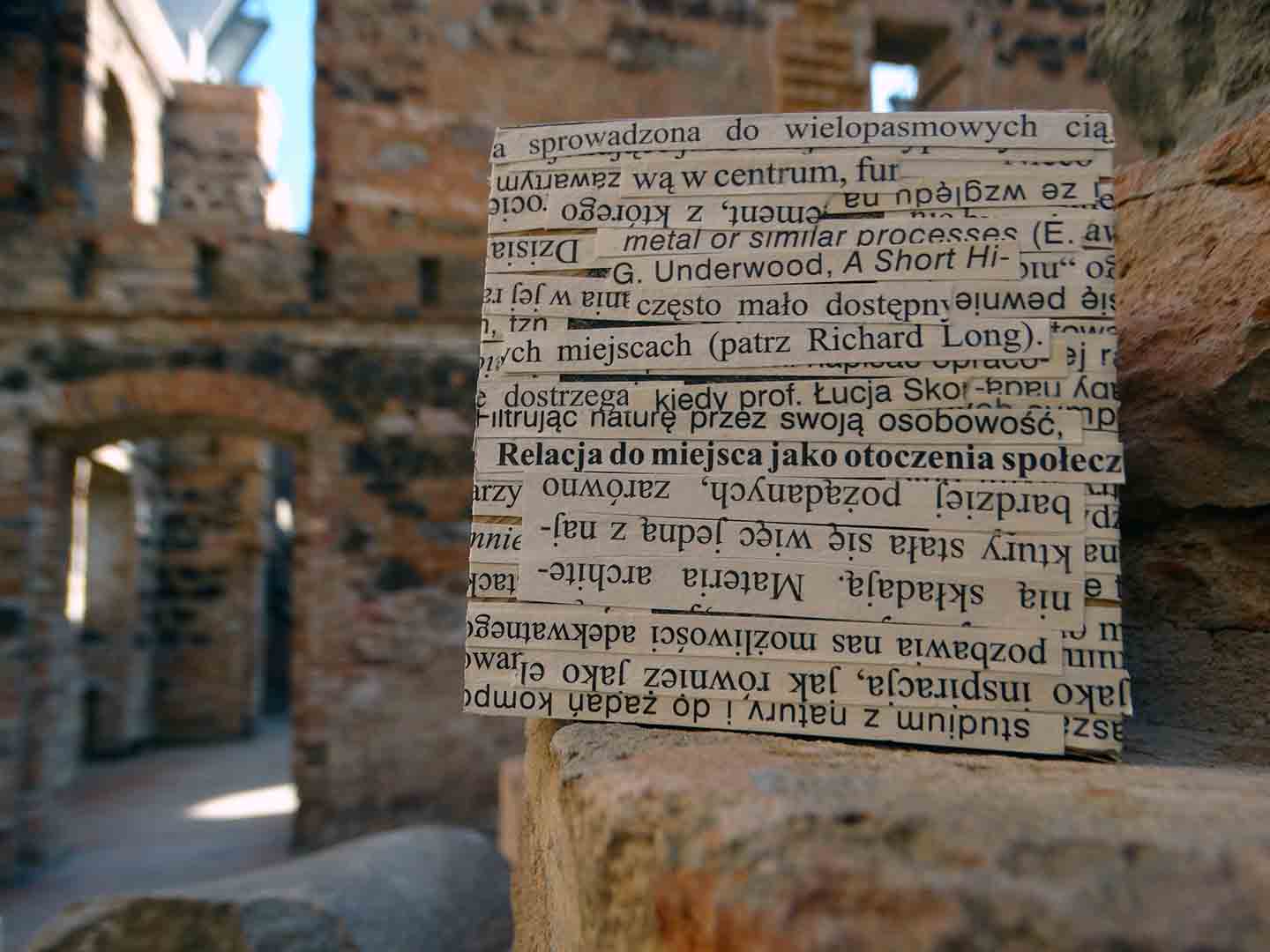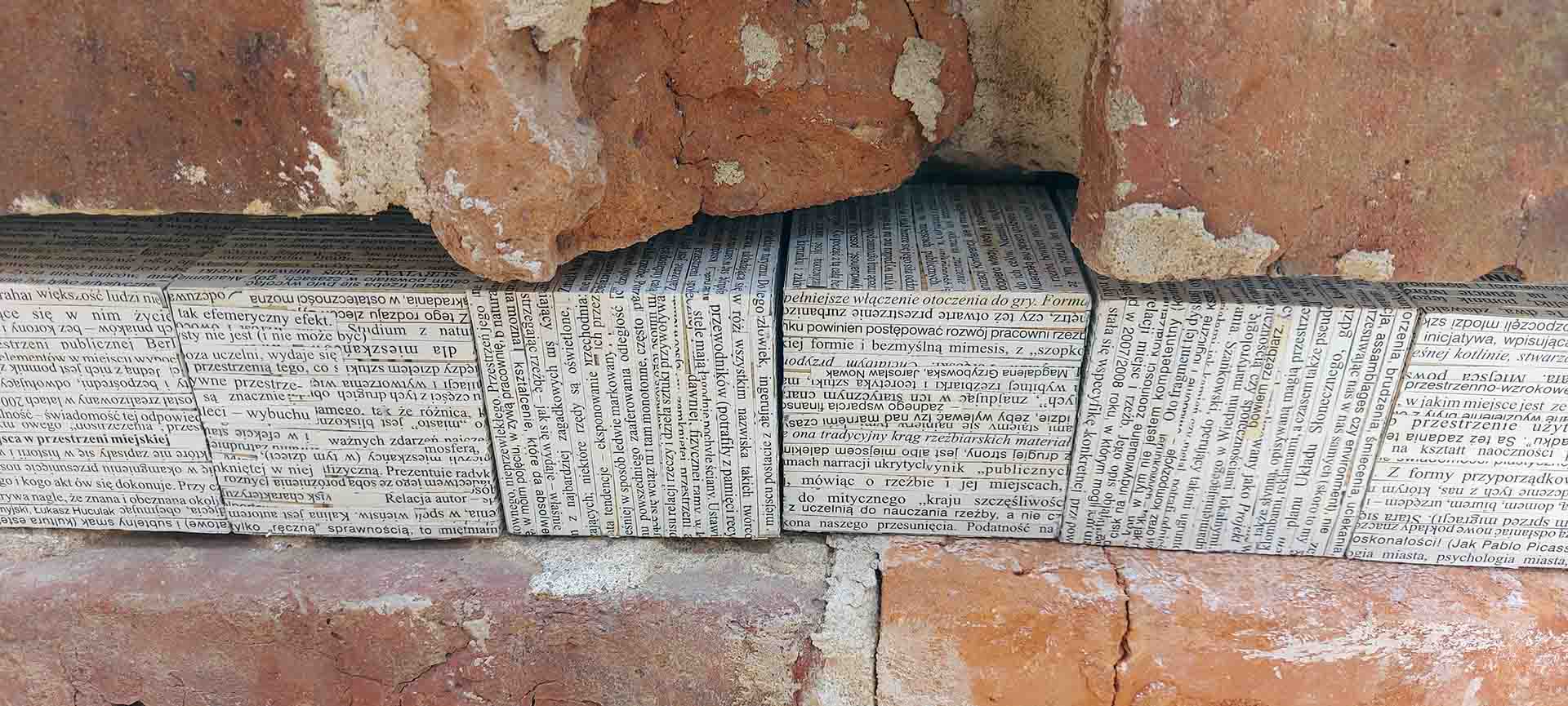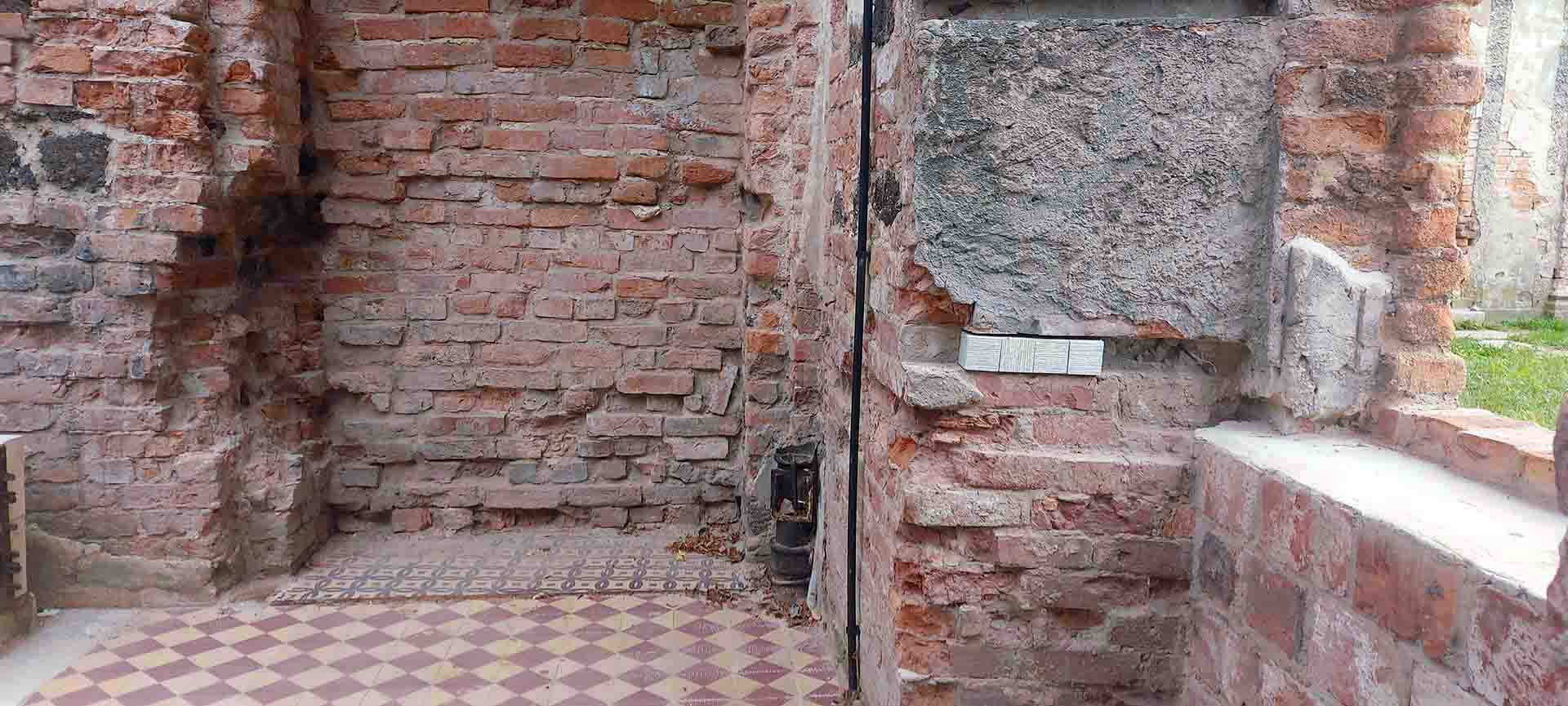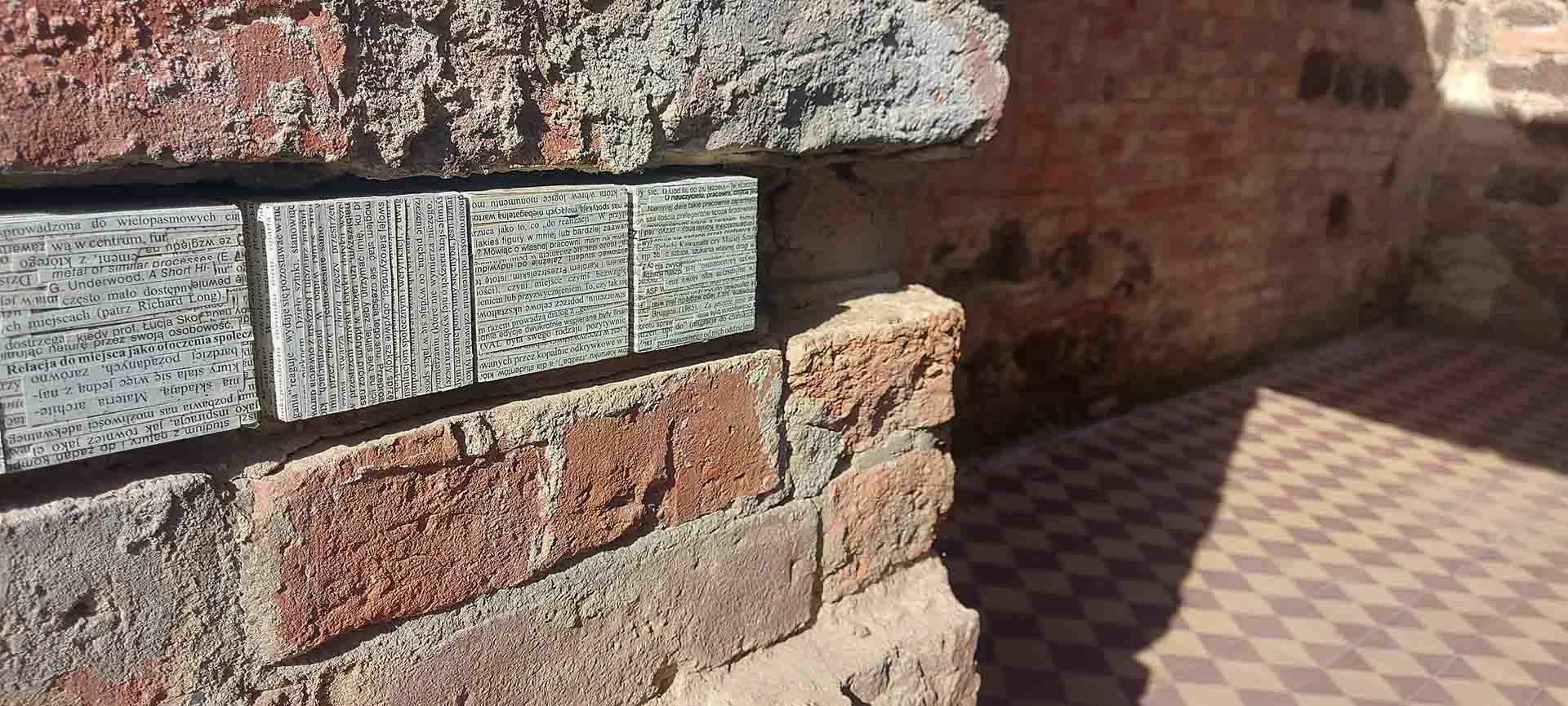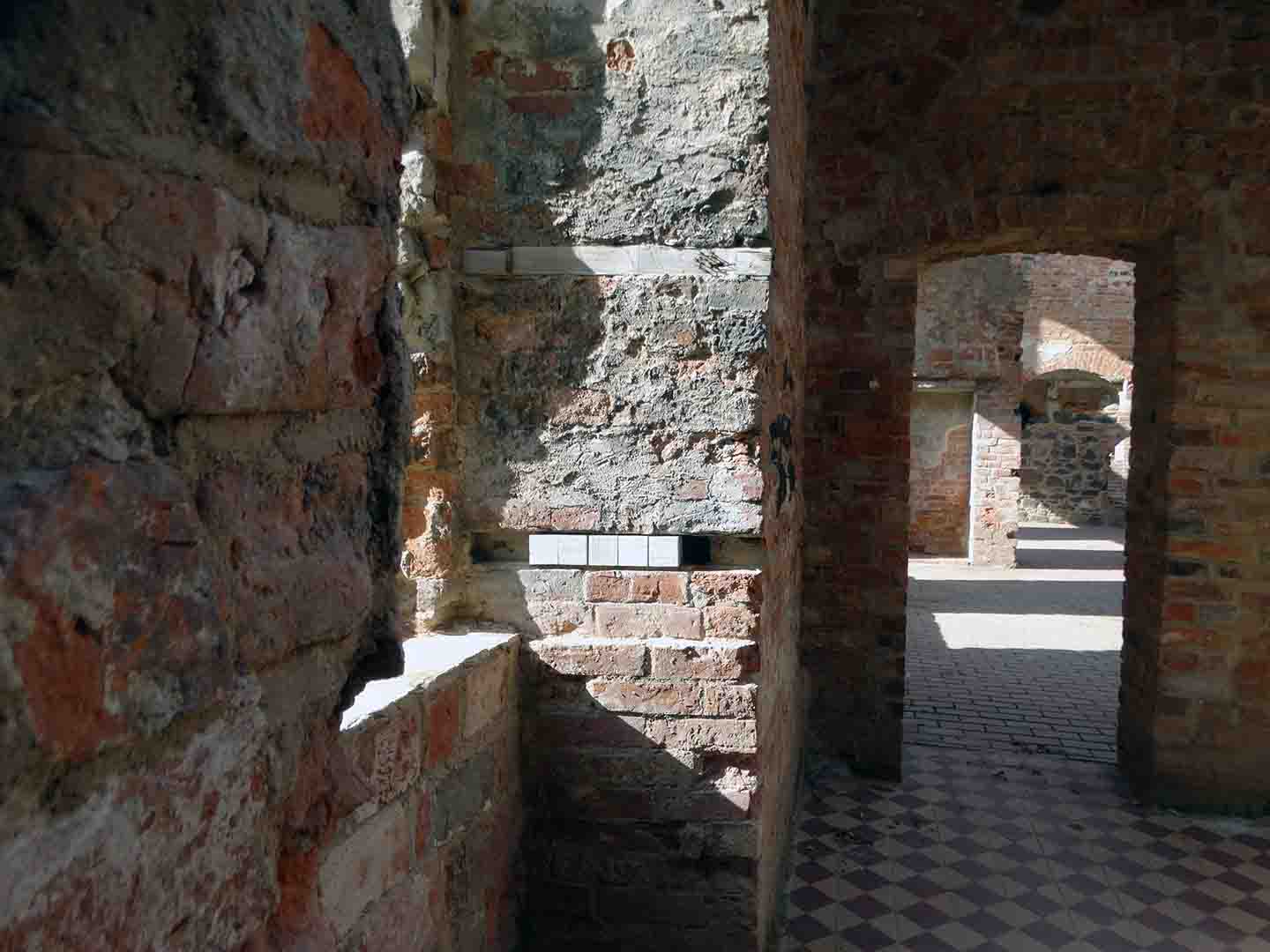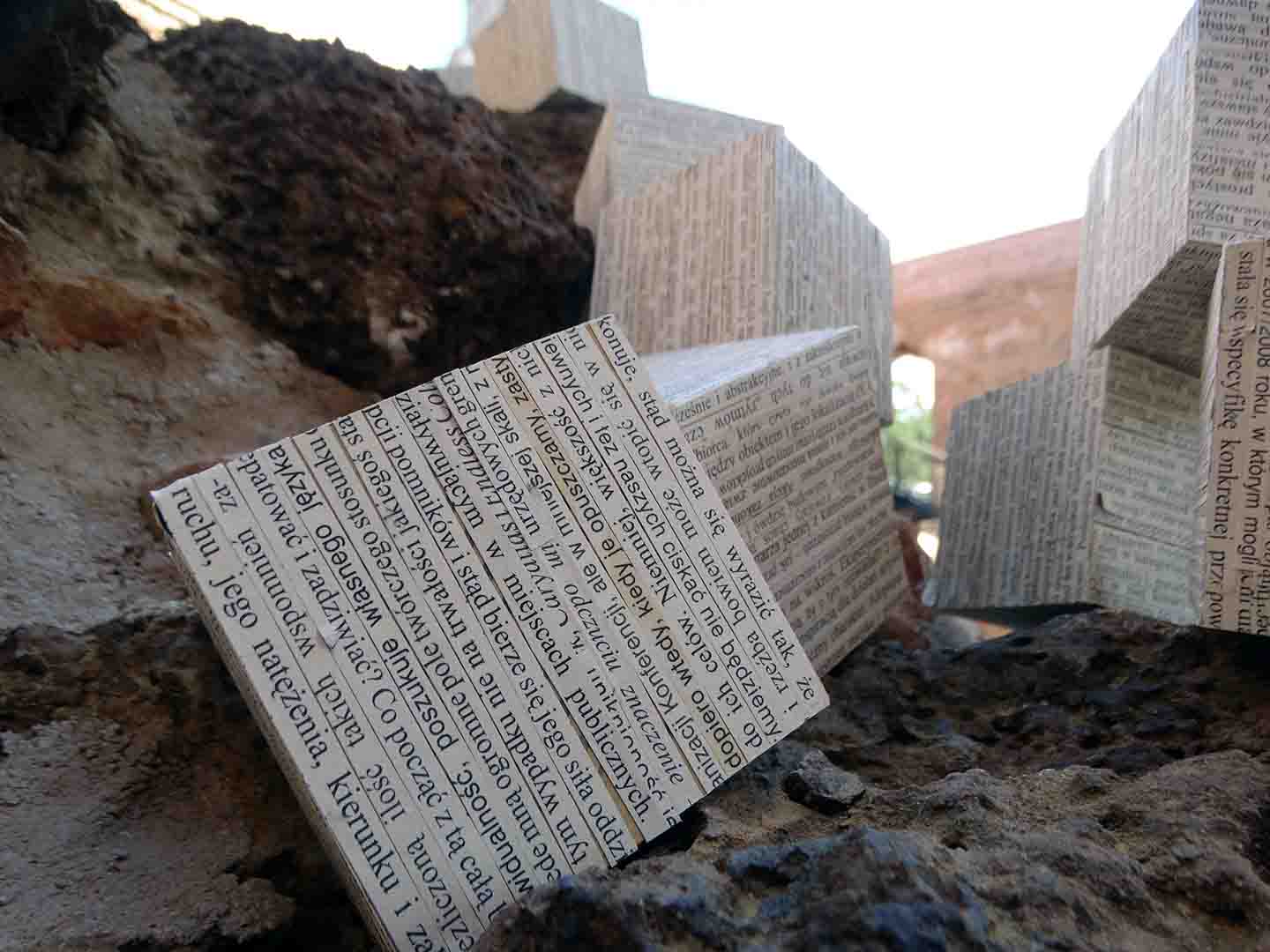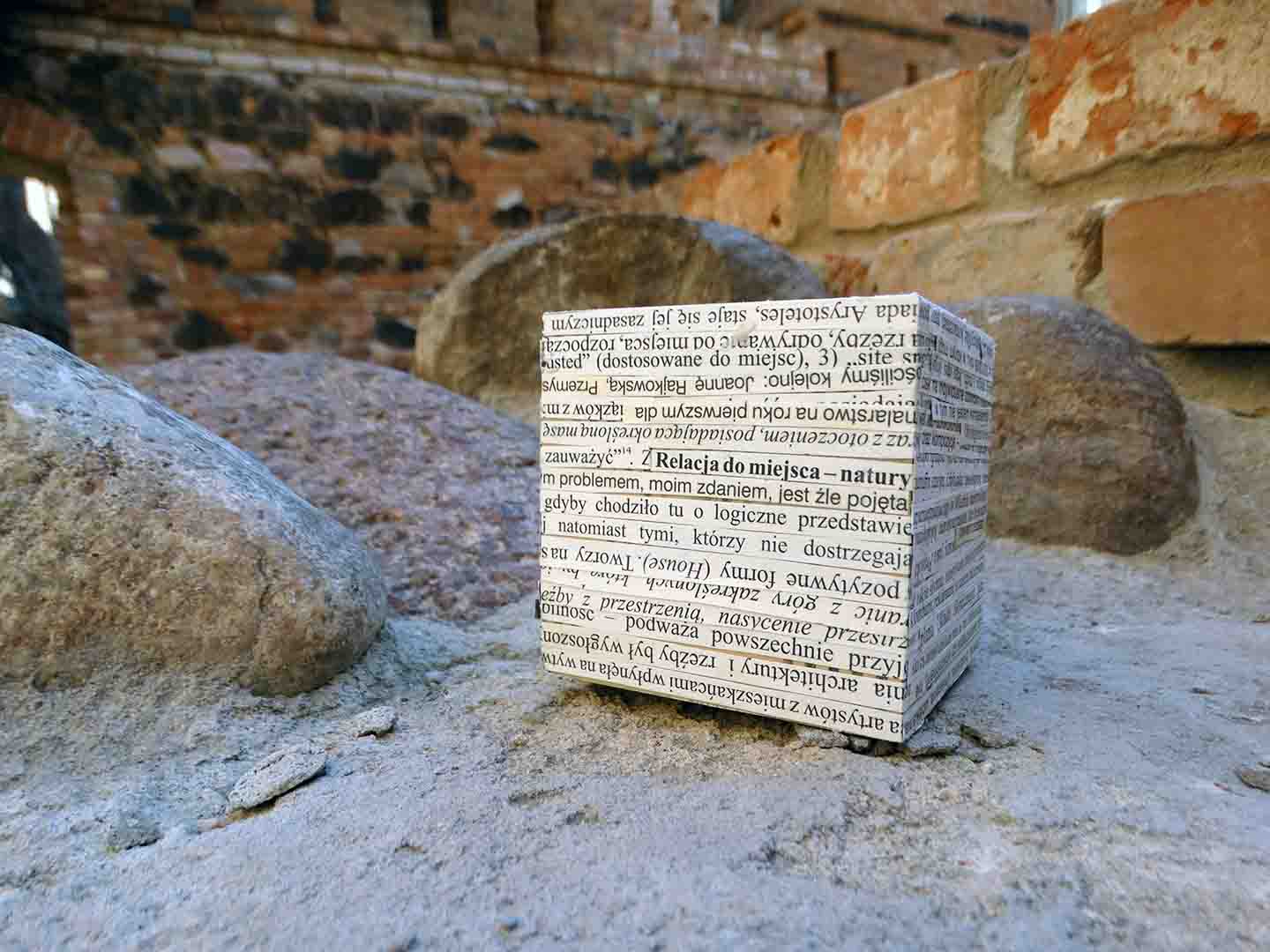TEXT AS A VISUAL FORM _ PODKOWA LEŚNA VILLA AIDA
Works from the series: "TEXT AS A VISUAL FORM_PODKOWA LEŚNA, VILLA AIDA", 2023 | Prace z cyklu: "TEKST JAKO FORMA WIZUALNA_PODKOWA LEŚNA, WILLA AIDA", 2025
Light projection on the walls of a historic building located in Podkowa Leśna near Warsaw, 11/05/2025, 10:17–10:35 PM | Projekcja świetlna na ścianach zabytkowego obiektu znajdującego się w podwarszawskiej miejscowości Podkowa Leśna, 11.05.2025, godz.: 22:17-22:35
Context of the site | Kontekst miejsca
Villa Aida is one of the oldest wooden villas in Podkowa Leśna, built at the end of the 19th century (c. 1900) as the summer and hunting residence of Stanisław Wilhelm Lilpop. It later became the first home of Anna and Jarosław Iwaszkiewicz, and throughout the interwar period the address drew literary circles, including those associated with the Skamander group. The building – larch timber, with a “Swiss-style” veranda – stands at 7 Jarosława Iwaszkiewicza Street and is listed as a valuable example of wooden resort architecture from the Warsaw region. Today it hosts cultural events (author talks, concerts, exhibitions), remaining an important point in the topography of local memory. | Willa Aida to jedna z najstarszych drewnianych willi w Podkowie Leśnej, wzniesiona pod koniec XIX wieku (ok. 1900) jako letni i myśliwski dom Stanisława Wilhelma Lilpopa. Później była pierwszym domem Anny i Jarosława Iwaszkiewiczów; przez ten adres przewijały się środowiska literackie dwudziestolecia, m.in. związane ze Skamandrem. Budynek – modrzewiowy, z werandą w „szwajcarskim” stylu – stoi przy ul. Jarosława Iwaszkiewicza 7 i figuruje w rejestrze zabytków jako cenny przykład drewnianej architektury letniskowej okolic Warszawy. Dziś pełni funkcje kulturalne (spotkania autorskie, koncerty, wystawy), pozostając ważnym punktem topografii lokalnej pamięci.
[ENG]
Light Projection on the Façade of Villa Aida (2025)
Late in the evening, the façade of Villa Aida becomes a page that cannot be closed. Wood—material susceptible to time, moisture, and the touch of light – receives the projection like a pencil trace on paper, but without the possibility of “fixing” it. The text appears and disappears; it is a temporary inhabiting of architecture by signs. In this sense, TEXT AS A VISUAL FORM is not an addition to the building but its temporary syntax: gutters form columns, windows act as paragraphs, the terrace sets the margin, and the viewer’s shadow takes the role of a comma. A simple technological intervention triggers a complex transformation: the house begins to speak a language that belongs neither to literature, nor to graphic design, nor to photography, though it draws from each of these practices.
The key gesture is a refusal of closure. Statements like [ ] is enough, meaning ≠ sentence, or this is not a message do not so much describe the situation as activate it. The bracket – empty yet full – becomes a way of framing the place: it points to a “here” without adding content. The viewer is invited to fill this frame with breath, step, memory. As a result, communication does not unfold in the sender–message–receiver model; it happens between the façade boards, the noise of projection, and the movement of the body that enters the cone of light. The text does not “carry” meaning; it sets relations in motion in which meaning can occur.
This relationality is temporal as well. The symbol ⧖ (suspension) and the formula ⧖ ≠ ∅ reverse the order in which a pause is treated as lack. The projection operates in a rhythm of flicker, breaks, micro-vibrations. Time is not empty: it is its density that allows reading. Hence ⧖ becomes language can be understood literally – pause as language – but also materially: the projection converts time into visibility, just as wood converts time into texture. Layers of varnish, knots, micro-cracks function here as equivalent “glyphs”; light merely activates them, turning the façade into a palimpsest.
A crucial thread is asemia. asemic. becoming. again. places the project within a tradition of writing that does not submit to the alphabet. Such refusal is ethical: instead of imposing a single, unambiguous message on a site embedded in private histories and local memories, the work offers openness. Asemia is not a lack of meaning, but a lack of the violence of meaning. That is why many formulas act as operators: truth is a direction, not a place does not stabilize truth – it indicates that truth is movement. The projection at Villa Aida does not erect a monument to truth; it draws a vector one may follow or push against.
In this sense the project is also a proposal for a social reading room. A house-usually an object of ownership and boundaries becomes a shared surface of reading. The audience does not assemble opposite a stage but circulates along the drive, under the eaves, by the gutters; with their shadows they co-write the sentences. The calligraphy of light has no author in the traditional sense it is co-created by the time of day, the humidity of the air, neighbors’ conversations, and accidental pauses. This “score” teaches another mode of reception: not collector-oriented, not documentary, but situational.
From the perspective of artistic practice, error is equally important. error is a form of art is not a simple apotheosis of the glitch, but a recognition that error is a cognitive method. Exposed to interference, distortion, and shift, the projection shows that knowledge happens in “noise” as much as in clarity. When a letter is unraveled by wind, when light breaks on the edge of a board, when a passerby’s shadow “ruins” the composition – precisely then an excess of sense appears. Villa Aida, imperfect because alive, becomes a laboratory for such an epistemology of error.
The series also has a self-reflective dimension. this is not a message plays with the paradigm of representation: here is a sentence that negates its own function yet cannot stop performing it. On the façade, the contradiction becomes visible: the building “says” that it does not speak. The paradox does not paralyze reading; on the contrary, it creates a space where the viewer can see the mechanism of communication how a sign becomes a sign even when it refuses to.
Finally, λ → ∞ / self introduces the subjective dimension. If the “I” is a process, then the projection on the façade operates as an external model of consciousness: a never-closed, pulsating stream of signs that approach a definition without reaching it. The “self” is not presented it is set in motion. The variable λ has no fixed value; likewise the subject is not a state of possession but a labor of becoming. In this context, Aida is not only an address; it is an instrument on which one can play what is constantly forming within the subject.
From these threads emerges an underlying thesis about responsibility. Since the work does not impose content but opens relations, responsibility is distributed across many elements: the artist, the site, the community, and the historical moment. art is responsibility here means accepting the consequences of silence, error, and indeterminacy. In a time overloaded with messages, the project proposes a different ethos an ethos of attentiveness. It is not about spectacular declaration, but about precisely measured gestures that listen to context (the wooden fabric of the villa, the memory of the garden, the micro-histories of the neighborhood). Art does not “appropriate” the façade; it reads it and returns it for reading.
That is why :: undefined yet real :: feels like a coda. The unnamed, not fully graspable, remains real perhaps most real because unassimilated. The light projection will leave no permanent mark on the boards; it will leave a mark on habits of looking. When the light goes out, Aida will be a house again. But for a while it was also a book without a last page. And that “without” – the careful economy of content, the minimal shift—turns out to be enough. [ ] is enough.
List of projections:
[ ] is enough
Emptiness can be sufficient. A bracket without content becomes a complete sign. Lack and silence can speak as strongly as excess; the unsaid becomes a message.
truth is a direction, not a place
Truth is not a state of possession but a being-in-motion. It is an orientation, not a goal – a direction that points the way rather than defining its end.
asemic. becoming. again.
Asemia is continual becoming. Each inscription opens the next and never reaches a final form. Asemic writing repeats in order to exist anew every time.
meaning ≠ sentence
Meaning does not fit inside the sentence. Grammar is often too tight; sense arises in gaps, errors, emotions, and reception. It is not the sentence that makes meaning – meaning escapes the sentence.
⧖ becomes language
Time turns into language. Silence, pause, and rhythm become carriers of communication. Semiography shows that meaning can emerge beyond the sentence – in the experience of time.
error is a form of art (stairs)
An affirmation of error/glitch; error as a practice of seeing and form-making.
error is a form of art (vertical)
Text as a “gutter-column” – a vertical inscription along the house’s edge.
truth is a direction, not a place (vertical)
Truth as a vector – vertical version.
[ ] is enough (vertical)
The bracket as a minimal frame – vertical version.
this is not a message (vertical)
The sentence refuses the role of a message and exposes the paradox of language. Mere presence generates meaning; refusal cannot free words from being signs.
⧖ ≠ ∅
Time is not emptiness. ⧖ denotes duration/suspension; ∅ denotes lack/void. Together they say that silence and waiting are charged with life – emptiness is a space of potential.
:: undefined yet real ::
The undefined exists as fully as the named. Ambiguity does not mean absence. The inexpressible has its own intense reality.
art grows where silence listens
Art grows where silence listens – an ethics of attentiveness as the soil of form.
λ → ∞ / self
The self is a process. Λ is a variable – motion and potential; the arrow toward ∞ marks non-closure. The subject continually approaches itself without ever attaining completeness – an equation written anew.
[PL]
Projekcja świetlna na fasadzie Willi Aida (2025)
Późnym wieczorem fasada Willi Aida staje się stroną, której nie da się zamknąć. Drewno – materiał podatny na czas, wilgoć i dotyk światła – przyjmuje projekcję jak ślad ołówka na papierze, ale bez możliwości „utrwalenia”. Tekst pojawia się i znika; jest chwilowym zamieszkaniem znaków w architekturze. W tym sensie TEXT AS A VISUAL FORM nie jest dodatkiem do budynku, lecz jego czasową składnią: rynny tworzą kolumny, okna działają jak akapity, taras wyznacza margines, a cień widza wchodzi w rolę przecinka. Prosta interwencja technologiczna uruchamia złożoną transformację: dom zaczyna mówić językiem, który nie należy ani do literatury, ani do grafiki, ani do fotografii, choć czerpie z każdej z tych praktyk.
Kluczowym gestem jest odmowa domknięcia. Hasła w rodzaju [ ] is enough, meaning ≠ sentence czy this is not a message nie tyle opisują sytuację, co ją uruchamiają. Nawias pusty, a jednak pełny staje się formą ramowania miejsca: wskazuje „tu” bez dodawania treści. Widz zostaje zaproszony do wypełnienia tej ramy własnym oddechem, krokiem, wspomnieniem. W efekcie komunikacja nie odbywa się w modelu nadawca -komunikat-odbiorca; odbywa się między deskami elewacji, projekcyjną szumowością i poruszeniem ciała, które wchodzi w stożek światła. Tekst nie „niesie” znaczenia, lecz uruchamia relacje, w których znaczenie może się wydarzyć.
Ta relacyjność jest również temporalna. Symbol ⧖ (zawieszenie) i formuła ⧖ ≠ ∅ odwracają porządek, w którym pauza bywa traktowana jako brak. Projekcja działa w rytmie migotania, przerw, mikrodrgań. Czas nie jest pusty: to jego gęstość pozwala na czytanie. Dlatego zdanie ⧖ becomes language można rozumieć dosłownie – pauza jako język – ale też materialnie: projekcja zamienia czas na widzialność, tak jak drewno zamienia czas na fakturę. Warstwy lakieru, sęki, mikrospękania są tu równorzędnymi „glifami”; światło tylko je uaktywnia, czyniąc z fasady palimpsest.
Ważnym wątkiem jest asemiczność. asemic. becoming. again. sytuuje projekt w tradycji pisma, które nie podlega alfabetowi. Taka odmowa jest etyczna: zamiast narzucać jednoznaczny komunikat miejscu, które istnieje w sieci prywatnych historii i lokalnych pamięci, praca oferuje otwartość. Asemia to nie brak znaczenia, lecz brak przemocy znaczenia. Dlatego wiele formuł ma charakter operatorów: truth is a direction, not a place nie stabilizuje prawdy i wskazuje, że prawda jest ruchem. Projekcja na Willi Aida nie tworzy więc pomnika prawdy, ale wektor, którym można pójść albo się od niego odbić.
W tym sensie projekt jest także propozycją społecznej czytelni. Dom – zwykle obiekt własności i granic – staje się wspólną powierzchnią lektury. Widownia nie zbiera się naprzeciw sceny, lecz krąży po podjeździe, pod dachem, przy rynnach; cieniem współpisze zdania. Kaligrafia światła nie ma autora w tradycyjnym sensie – jest współtworzona przez porę dnia, wilgotność powietrza, sąsiedzkie rozmowy i przypadkowe zatrzymania. Ta „partytura” uczy innego odbioru sztuki: nie kolekcjonerskiego, nie dokumentacyjnego, lecz sytuacyjnego.
Z poziomu praktyki artystycznej istotny jest również wątek błędu. error is a form of art nie jest prostą apoteozą glitchu, ale uznaniem, że błąd jest metodą poznawczą. Projekcja, wystawiona na zakłócenia, zniekształcenia, przesunięcia, pokazuje, że poznanie dokonuje się w „szumie” tak samo jak w klarowności. Gdy literę rozsnuwa wiatr, gdy światło łamie się na krawędzi deski, kiedy cień przechodnia „psuje” kompozycję — właśnie wtedy pojawia się nadwyżka sensu. Willa Aida, nieidealna, bo żywa, staje się laboratorium dla takiej epistemologii błędu.
Seria ma także wymiar autorefleksyjny. this is not a message gra z paradygmatem reprezentacji: oto zdanie, które neguje własną funkcję, a jednak nie może przestać jej pełnić. Na elewacji ta sprzeczność staje się widzialna: budynek „mówi”, że nie mówi. Paradoks nie paraliżuje jednak czytania; przeciwnie, tworzy przestrzeń, w której odbiorca może zobaczyć mechanizm komunikacji — to, jak znak staje się znakiem, nawet gdy nie chce.
Wreszcie, λ → ∞ / self wprowadza wymiar podmiotowy. Jeśli „ja” jest procesem, projekcja na fasadzie działa jak zewnętrzny model świadomości: nigdy domknięty, pulsujący strumień znaków, które zbliżają się do definicji, lecz nie osiągają jej. „Self” nie zostaje przedstawione – zostaje uruchomione jako ruch. Zmienna λ nie ma stałej wartości; podobnie podmiot nie jest stanem posiadania, lecz pracą nad sobą. W tym kontekście Aida nie jest tylko adresem; jest instrumentem, na którym można zagrać to, co w podmiocie nieustannie się formuje.
Z powyższych wątków wyrasta podskórna teza o odpowiedzialności. Skoro praca nie narzuca treści, lecz otwiera relacje, to odpowiedzialność rozkłada się na wiele elementów: na artystę/kę, na miejsce, na wspólnotę i na moment historyczny. art is responsibility oznacza tu: przyjęcie konsekwencji ciszy, błędu i niedopowiedzenia. W czasie przeciążonym komunikatami, projekt proponuje inny etos — etos uważności. Nie chodzi o spektakularną deklarację, lecz o precyzyjnie dozowane gesty, które wsłuchują się w kontekst (drewniana tkanka willi, pamięć ogrodu, mikrohistorie sąsiedztwa). Sztuka nie „zawłaszcza” fasady; ona ją czyta i oddaje do czytania.
Dlatego właśnie :: undefined yet real :: wydaje się puentą. Nienazwane, nie w pełni uchwytne, pozostaje realne – być może najbardziej realne, bo nieoswojone. Projekcja światła nie zostawi trwałego śladu na desce; zostawi ślad w nawykach patrzenia. Gdy światło zgaśnie, Aida znowu będzie domem. Ale przez jakiś czas była także książką bez ostatniej strony. I to „bez” — ta ostrożna ekonomia treści, to minimalne przesunięcie — okazuje się wystarczające. [ ] is enough.
Wykaz projekcji:
[ ] is enough
Pustka bywa wystarczająca. Nawias bez treści staje się pełnym znakiem. Brak i cisza potrafią mówić równie mocno jak nadmiar; niewypowiedziane staje się komunikatem.
truth is a direction, not a place
Prawda nie jest stanem posiadania, lecz byciem w ruchu. To orientacja, nie cel – kierunek, który wskazuje drogę zamiast definiować jej koniec.
asemic. becoming. again.
Asemia jest nieustannym stawaniem się. Każdy zapis otwiera następny – nigdy nie osiąga ostatecznej formy. Pisanie asemiczne powtarza się, by za każdym razem zaistnieć na nowo.
meaning ≠ sentence
Znaczenie nie mieści się w zdaniu. Gramatyka bywa zbyt ciasna; sens rodzi się w przerwach, błędach, emocjach i odbiorze. Nie zdanie tworzy sens – sens wymyka się zdaniu.
⧖ becomes language
Czas zamienia się w język. Milczenie, pauza, rytm stają się nośnikami komunikacji. Semiografia pokazuje, że sens może powstawać poza zdaniem – w doświadczeniu czasu.
error is a form of art (schody)
Afirmacja błędu/glitchu; błąd jako praktyka widzenia i wytwarzania formy.
error is a form of art (pion)
Tekst jako „kolumna z rynny” – pionowy zapis na krawędzi domu.
truth is a direction, not a place (pion)
Prawda jako wektor – wersja pionowa.
[ ] is enough (pion)
Nawias jako minimalna rama – wersja pionowa.
this is not a message (pion)
Zdanie odmawia roli komunikatu i ujawnia paradoks języka. Sama obecność generuje znaczenie; odmowa nie uwalnia słów od bycia znakami.
⧖ ≠ ∅
Czas nie jest pustką. ⧖ oznacza trwanie i zawieszenie; ∅ – brak. Zestawione mówią, że cisza i oczekiwanie są naładowane życiem – pustka to przestrzeń potencjału.
:: undefined yet real ::
Niezdefiniowane istnieje równie mocno jak nazwane. Brak jednoznaczności nie oznacza braku obecności. Niewyrażalne miewa własną, intensywną realność.
art grows where silence listens
Sztuka wyrasta tam, gdzie milczenie słucha – etyka uważności jako gleba formy.
λ → ∞ / self
„Ja” jest procesem. Λ to zmienna – ruch i potencjał; strzałka ku ∞ oznacza brak domknięcia. Podmiot stale zbliża się do siebie, nie osiągając pełni, równanie pisane od nowa.

